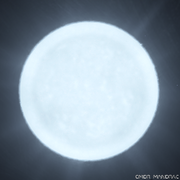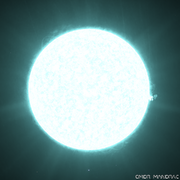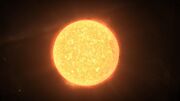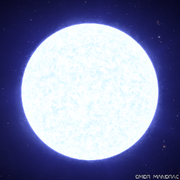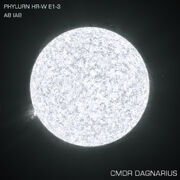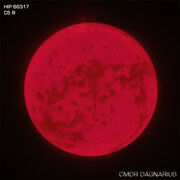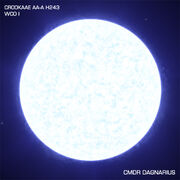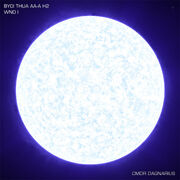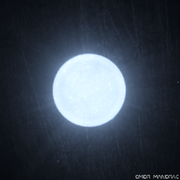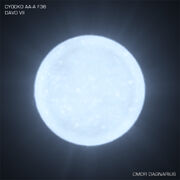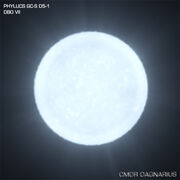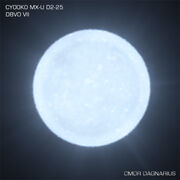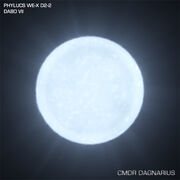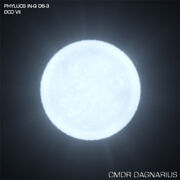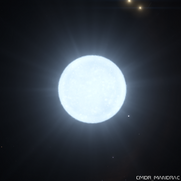There are a wide variety of stars in the galaxy which are classified by types and subtypes. A star system can have more than one star, some of which may not be used to refuel with a Fuel Scoop.
A star is a giant ball with extremely hot gas (plasma). It's caused by nuclear fusion which turns hydrogen into helium. All this energy produces heat, light and bigger chemical elements. A star emits electromagnetic radiation that moves away from the star as light. The large mass of a star holds it together. Old stars change helium into other elements like carbon and oxygen.
The Largest Stars page has a list of famous stars in the Milky Way.
Stellar Classification
Each star or dwarf in Elite: Dangerous has an identifier for its classification which conforms to the Morgan–Keenan (MK) classification system.
For example, the Sun of Sol has the classification identifier: G2 V
Each identifier consists of three components:
- Spectral class: A capital letter out of the sequence: O, B, A, F, G, K, M. (A helpful real-world mnemonic for remembering this is, "Oh Be A Fine Girl, Kiss Me.") This mainly specifies the temperature ranging from O (hottest) to M (coolest). Other letters specify extensions to this classification system, namely: W, L, T, Y, C, S, D. A few of those classes have subclasses such as DA, DB and DC as subclasses of D.
- Spectral subclass: Each letter class is then subdivided using a numeric digit with 0 being the hottest and 9 being the coolest.
- Luminosity class: A luminosity class is added to the spectral class using Roman numerals.This classifies the stars by its spectral characteristics considering color and brightness. Those spectral characteristics provide information about the type of the star:
- I for supergiants
- Ia or 0 for hypergiants or extremely luminous supergiants
- Iab for normal supergiants
- Ib for less luminous supergiants
- II for bright giants
- III for regular giants
- IV for sub-giants
- V for main-sequence stars (most of the known stars belong to this class)
- Va for extremely luminous main sequence stars
- Vab for luminous main sequence stars
- Vb for normal main sequence stars
- Vz for less luminous main sequence stars
- VI for sub-dwarfs
- VII for white dwarf
Thus, G2 V means: The Sun is semi hot (G), it belongs to the hotter stars (2) in class G and it is considered as a so called main-sequence star (V).
Star Types
 |
This section requires updates
Some images of stars include text and/or is credited in the picture itself, these images should be replaced with images not containing any text. |
| Image | Class | Fuel-Scoopable | Rarity | Description |
|---|---|---|---|---|
| M | Yes | Very Common | Class M stars are red stars that form the bulk of the main sequence stars in the galaxy. their mass is low, as is their surface temperature.
| |
| K | Yes | Common | Class K stars are yellow-orange main sequence stars with a long and generally stable life. They range in mass from 0.6 to 0.9 solar masses and have a surface temperature reaching 5,000 K.
| |
| L | No | Common | Class L dwarfs are dwarf stars that are cooler than M class stars. They are on the borderline of supporting fusion of hydrogen in their cores, and their temperatures range from 1,300 to 2,400 K, cool enough to have alkaline metals and metal hydrides in their atmospheres.
| |
| T | No | Common | Class T dwarfs are brown dwarfs with a surface temperature between 700 and 1,300 K. They are sometimes known as Methane Dwarfs due to the prominence of methane in their composition. They are on the borderline between what might be considered a very large gas giant planet and a star.
| |
| G | Yes | Uncommon | Class G stars are white-yellow main sequence stars. They range in mass from 0.8 to 1.2 solar masses and have a surface temperature reaching 6,000 K.
| |
| F | Yes | Uncommon | Class F stars are white main sequence stars. They range in mass from 1 to 1.4 solar masses and have a surface temperature reaching 7,600 K.
| |
| Y | No | Uncommon | Class Y dwarfs are the coolest of brown dwarfs. Surface temperatures are less than 700 K, and are effectively very large gas giant planets, with some stellar properties.
| |
| TTS | No | Uncommon | T Tauri type stars are very young stars which are in the process of gravitational contraction. Note: Take caution when traveling and using a fuel scoop, as the TTS' appearance often resembles M or K stars.
| |
| A | Yes | Very Uncommon | Class A stars are hot white or bluish white main sequence stars. They range in mass from 1.4 to 2.1 solar masses and have a surface temperature reaching 10,000 K.
| |
| B | Yes | Very Uncommon | Class B stars are very luminous blue-white stars. They range in mass from 2 to 16 solar masses and have a surface temperature reaching 30,000 K. Their lifetimes are shorter than most main sequence stars.
| |
| Orange Giant
(K) |
Yes | Rare | Orange giant stars with spectral type K. Orange giants like this are reaching the end of their lives, and have moved off the main sequence. Hydrogen has stopped fusing in the core, leaving a collapsed core of degenerate helium, and hydrogen burning is taking place in an outer shell as the star continues to expand.
| |
| Red Giant
(M) |
Yes | Rare | Red giants are in the latter part of their lives. Hydrogen has stopped fusing in their degenerate helium cores and has moved to an outer shell, causing the star to expand. The outer atmosphere is inflated and tenuous, and the surface temperature is below 5,000 K.
| |
| Black Hole | No | Rare | Black holes are typically the stellar remnants of super massive stars of twenty solar masses or more, that have reached the end of their lives. Nuclear fusion has ceased, and the star collapsed to the most extreme point possible - where gravity is so extreme light itself can no longer escape. If matter should fall on to such a body, an extreme burst of gamma radiation will be emitted, but otherwise the body is only visible by the gravitational distortion in the vicinity. In many cases black holes can be seen emitting brightly in X-rays because of matter falling on to their surface from a companion body. | |
| S | No | Very rare | Class S stars are a late-type giant star (similar to class K5–M) whose spectrum displays bands from zirconium oxide, in addition to the titanium oxide bands characteristically exhibited by K and M class giant stars.
| |
| O | Yes | Very Rare | Class O type stars are the most luminous and massive main sequence stars in the galaxy. They range in mass from 15 to 90 solar masses and burn very brightly indeed, with a surface temperature reaching 52,000 K so appear very blue. They are very short lived with lifetimes of 1 - 10 million years, ending in supernova.
| |
| Neutron Star | No | Rare | Neutron stars are the stellar remnants of massive stars that have reached the end of their lives. Once nuclear fusion was exhausted, the star collapsed into a tiny volume. Because of its high mass, the matter has collapsed into Neutron-degenerate matter (sometimes called Neutronium), an extremely high density state made up entirely of neutrons (matter composed of stuff other than atoms, such as quarks, protons, neutrons or whatever, is referred to as "degenerate matter"). Unlike most degenerate matter where electrons are below the Fermi-Energy (chemical potential at T=0), the compression is so great that the Fermi-Energy of the electrons increases such that they combine with protons to form neutrons. As the star is in equilibrium, its gravity is balanced by 'neutron degeneracy pressure' (compressed neutron wave functions which are energetic due to the uncertainty principle), though with more mass the system's gravity would overcome the neutron degeneracy pressure forming a black hole. Degenerate matter stars are as dense as matter can possibly be without becoming a black hole.
Note: Take caution when approaching these stars, as they are so tiny they are almost invisible. They still radiate heat, and getting closer than 0.25Ls will cause one's heat to build up. If you fly with your ship into the emitted energy cloud your FSD will be super-loaded and the jump range for the next jump will be dramatically increased. | |
| Blue-White Supergiant
(A, B) |
Yes | Very Rare | Class A blue-white supergiant star. It is approaching the end of its life and hydrogen burning has stopped in its core, and star has begun expanding towards being red supergiant.
| |
| Yellow-White Supergiant
(F, G) |
Yes | Very Rare | Class F yellow-white supergiant star. It is approaching the end of its life and hydrogen burning has stopped in its core, and star has begun expanding towards being red supergiant.
| |
| MS | No | Ultra Rare | MS class stars are late sequence stars having progressed from the S class stage of their life cycle and heading towards becoming a carbon star, a star nearing the end of its stellar life.
| |
| Carbon (C) | No | Ultra Rare | Carbon class stars are stars approaching the end of their life. A carbon star is a late-type star similar to a red giant (or occasionally to a red dwarf) whose atmosphere contains more carbon than oxygen; the two elements combine in the upper layers of the star, forming carbon monoxide, which consumes all the oxygen in the atmosphere, leaving carbon atoms free to form other carbon compounds, giving the star a "sooty" atmosphere and a strikingly ruby red appearance. The surface temperature is rarely higher than 4300 K.
| |
| C-N, CN | No | Ultra Rare | Class C-N stars are variants of carbon class stars, stars that are approaching the end of their stellar lives as hydrogen fusion begins to stop. They were once K or M type stars that have degenerated to the carbon phase of their life cycle.
| |
| C-J, CJ | No | Ultra Rare | C-J Class stars are variants of carbon class stars, stars that are approaching the end of their stellar lives as hydrogen fusion begins to stop. This CJ variant has much more carbon-13 in its atmosphere.
| |
| Red Supergiant
(K, M) (A, B, F, G)? |
Yes | Ultra Rare | Red supergiants are massive stars near the end of their lives. They have entered a helium burning phase, where helium is fused into carbon and oxygen. they have enormous sizes swelling up to many hundred solar diameters - up to 7 AU in some cases. their out reaches can be quite cool - typically 3500-4500 K.
| |
|
Herbig AE/BE star (DRYAO AOSCS sector) |
AE/BE | No | Legendary (More common in the galactic center) | Herbig Ae/Be stars are young stars typically less than 10 million years old with characteristics of either A or B class main sequence stars. They are usually between 2 and 8 solar masses. The mass of the proto-star determines its spectral class when it joins the main sequence.
|
| Wolf-Rayet (W) | No | Legendary
(A lot in CSI Systems and other Nebulas) |
Wolf-Rayet class stars are massive stars that are nearing the end of their life cycle and have moved out of their hydrogen-burning phase. They were once over 20 solar masses but now shed considerable amounts of material through solar wind. Their surface temperature can reach 200,000 K, so they appear a brilliant blue.
| |
| Wolf-Rayet C Star (WC) | No | Very Rare (mostly in AA-A named systems) | Wolf-Rayet class stars are massive stars that are nearing the end of their life cycle and have moved out of their hydrogen-burning phase. They were once over 20 solar masses but now shed considerable amounts of material through solar wind. Their surface temperature can reach 200,000 K, so they appear a brilliant blue. This star is a variant of the Wolf-Rayet stars whose spectrum is dominated by ionised carbon lines.
| |
| Wolf-Rayet O Star (WO) | No | Very Rare (mostly in AA-A named systems) | Wolf-Rayet class stars are massive stars that are nearing the end of their life cycle and have moved out of their hydrogen-burning phase. They were once over 20 solar masses but now shed considerable amounts of material through solar wind. Their surface temperature can reach 200,000 K, so they appear a brilliant blue. This star is a variant of the Wolf-Rayet stars whose spectrum is dominated by ionised oxygen lines.
| |
| Wolf-Rayet NC Star (WNC) | No | Very Rare (mostly in AA-A named systems) | Wolf-Rayet class stars are massive stars that are nearing the end of their life cycle and have moved out of their hydrogen-burning phase. They were once over 20 solar masses but now shed considerable amounts of material through solar wind. Their surface temperature can reach 200,000 K, so they appear a brilliant blue. This star is a variant of the Wolf-Rayet stars whose spectrum is dominated by ionised nitrogen, carbon-oxygen and helium lines.
| |
| Wolf-Rayet N Star (WN) | No | Very Rare (mostly in AA-A named systems) | Wolf-Rayet class stars are massive stars that are nearing the end of their life cycle and moved out of their hydrogen-burning phase. They were once over 20 solar masses but now shed considerable amounts of material through solar wind. Their surface temperature can reach 200,000 K, so they appear a brilliant blue. This star is a variant of the Wolf-Rayet stars whose spectrum is dominated by ionised nitrogen and helium lines.
| |
| Supermassive Black Hole | No | Unique
(Sagittarius A only) |
Supermassive Black Holes tend to form when an initial Black Hole begins to swallow even more mass including other Black Hole. With time they acquire a vast mass - and become a key compoment of the galaxy. With much of the other galactic mass rotating around them and can be several million solar masses. |
White Dwarves
Since there are many different subtypes of white dwarves they get a separate section.[1]
D: Degenerate (white dwarf) bodies
White dwarfs are the collapsed core of a star that has lost a large proportion (~20%) of its original mass as the ejected material of a planetary nebula or in a supernova explosion, the terminal stages of stellar evolution. White dwarfs are not stars because they no longer sustain nuclear fusion, and lacking this interior thermal source of support the star has gravitationally collapsed to a very small radius. White dwarfs glow with the residual heat of the degenerate core, which can have a temperature well above 100,000 K at collapse and that cools over several billion years. Class D is further divided into spectral types that indicate the elemental composition of the photosphere.
- DA: strong Balmer series hydrogen absorption lines only; no helium or metals present.
- DB: strong He I (neutral helium) absorption lines only; no hydrogen or metals present.
- DC: a continuous (blackbody) spectrum with no absorption lines deeper than 5% in any part of the electromagnetic spectrum.
- DO: strong lines of He II (ionized helium) with molecular hydrogen or helium present.
- DQ: carbon absorption lines, either atomic or molecular, in any part of the electromagnetic spectrum.
- DZ: metal (elements heavier than helium) absorption lines in the absence of both hydrogen and helium lines.
Symbols Appended to the Above Designations
- P: magnetic white dwarfs with detectable polarization.
- H: magnetic white dwarfs without polarization.
- X: peculiar or unclassifiable spectrum.
- E: emission lines (of any element) present.
- ?, :: uncertain classification.
- V: variable luminosity.
- d: circumstellar dust.
- C I, C II, O I, O II added within parentheses to indicate the presence of these elements in DQ objects.
The current practice is to append numerical indicators of the white dwarf temperature and surface gravity, separated by an underline "_". Temperature is indicated as the effective surface temperature divided into 50400 and rounded to the first decimal place, e.g. DA.9 = 56000 K and DB1.2 = 42000 K. Gravity is assessed as the width of the dominant spectral lines and the log values range from 7 to 9.
The table below are the white dwarves subtypes found in the Elite Dangerous game. These do not necessarily match the notation mentioned above (for example, ED uses DAZ which probably should be DZ) but comes very close. Although all white dwarves are considered Very Rare to find, the rarity column in the table below has been updated to indicate subtype rarity. This is based on subjective findings so far and might change.
 |
This section requires updates
Some images of stars include text and/or is credited in the picture itself, these images should be replaced with images not containing any text. |
| Image | Class | Fuel-Scoopable | Rarity | Description |
|---|---|---|---|---|
| DA | No | Very Common | Class DA stars are white dwarf stars with a hydrogen rich atmosphere. Note: Take caution when approaching these stars, as their heat radius is surprisingly large for their size.
| |
| DAV | No | Common | DAV class stars are also known as pulsating white dwarfs as their luminosity changes according to non-radial gravity waves within the star. They have hydrogen rich atmospheres.
| |
| DB | No | Rare | Class DB stars are white dwarf stars with a helium rich atmosphere with neutral helium emission lines.
| |
| DBV | No | Common | DBV class stars are known as pulsating white dwarfs as their luminosity changes according to non-radial gravity waves within the star. They have helium rich atmospheres.
| |
| DAB | No | Common | Class DAB stars are white dwarf stars with hydrogen and helium rich atmospheres and neutral helium emission lines.
| |
| DC | No | Very Common | Class DC stars have a continuous (blackbody) spectrum with no absorption lines deeper than 5% in any part of the electromagnetic spectrum.
| |
| DCV | No | Common | Class DCV stars are white dwarfs with varying luminosity.
| |
| DQ | No | Very Rare | Class DQ stars are white dwarfs with a carbon rich atmosphere.
| |
| DAZ | No | Very Rare | Class DAZ stars are white dwarfs which are hydrogen rich metallic stars.
|
Other Stellar Objects
Pulsars
In-game description unknown.
- Fuel scoop-able: No
- Legendary
Note: As of Beta 2.2, pulsars and millisecond pulsars are confirmed to be in the game; they do not, however, have unique descriptions. Crab Pulsar, one of known pulsars in our galaxy, is described in the game as a neutron star which is technically correct as pulsars are a special kind of neutron stars with fast spin.









